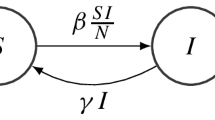Abstract
For linear compartment models or Leslie-type staged population models with quasi-positive matrix the spectral bound of the matrix (the eigenvalue determining stability) is studied in the situation where particles or individuals leave a compartment or stage with some rate and enter another with the same rate. Then the matrix carries the rate with a positive sign in some off-diagonal entry and with a negative sign in the corresponding diagonal entry. Hence the matrix does not depend on the rate in a monotone way. It is shown, however, that the spectral bound is a monotone function of the rate. It is all the time strictly increasing or strictly decreasing or it is constant. A simple algebraic criterion distinguishes between the three cases. The results can be applied to linear systems and to the stability of stationary states in non-linear systems, in particular to models for the transmission of infectious diseases, and in population dynamics.
Similar content being viewed by others
References
Anderson R.M., May R.M.: Population biology of infectious diseases. Part I. Nature 280, 361–367 (1979)
Boldin B.: Introducing a population into a steady community: the critical case, the center manifold, and the direction of bifurcation. SIAM J. Appl. Math. 66, 1424–1453 (2006)
Cohen J.E.: Convexity of the dominant eigenvalue of an essentially nonnegative matrix. Proc. Am. Math. Soc. 81, 657–658 (1981)
Diekmann O., Heesterbeek J.A.P.: Mathematical Epidemiology of Infectious Diseases. Wiley, New York (2000)
Faeth S.H., Hadeler K.P., Thieme H.R.: An apparent paradox of horizontal and vertical disease transmission. J. Biol. Dyn. 1, 45–62 (2007)
Hadeler K.P.: Quiescent phases and stability. Lin. Alg. Appl. 428, 1620–1627 (2008)
Hadeler K.P., Hillen T.: Coupled dynamics and quiescent phases. In: Alletti, G., Burger, M., Micheletti, A., Morale, D.(eds) Math Everywhere: Deterministic and Stochastic Modelling in Biomedicine, Economics and Industry, pp. 7–23. Springer, New York (2007)
Hyman J.M., Li J., Stanley E.A.: The differential infectivity and staged progression models for the transmission of HIV. Math. Biosci. 155, 77–109 (1999)
Kato T.: Superconvexity of the spectral radius, and convexity of the spectral bound and the type. Math. Z. 180, 265–273 (1982)
Kingman J.F.C.: A convexity property of positive matrices. Q. J. Math. Oxf. Ser. 2, 283–284 (1961)
Malik T., Smith H.L.: A resource-based model of microbial quiescence. J. Math. Biol. 53, 231–252 (2006)
Müller J., Hadeler K.P.: Monotonicity of the number of passages in linear chains and of the basic reproduction number in epidemic models. Z. Anal. Anwendungen 19, 61–75 (2000)
Nussbaum R.D.: Convexity and log convexity of the spectral radius. Lin. Alg. Appl. 73, 59–122 (1986)
Tam B.-S., Schneider H.: Linear equations over cones and Collatz-Wielandt numbers. Lin. Alg. Appl. 363, 295–332 (2003)
, : Epidemic and demographic interaction in the spread of potentially fatal diseases in growing populations. Math. Biosci. 111, 99–130 (1992)
van den Driessche P., Watmough J.: Reproduction numbers and sub-threshold endemic equilibria for compartmental models of disease transmission. Math. Biosci. 180, 29–48 (2002)
Webb G.F.: Convexity of the growth bound of C 0-semigroups of operators. In: Goldstein, G.R., Goldstein, J.A.(eds) Semigroups of Linear Operators and Applications, pp. 259–270. Kluwer, Dordrecht (1993)
Weinberger H.F.: Remark on the preceding paper by Lax. Comm. Pure Appl. Math. 11, 195–196 (1958)
Author information
Authors and Affiliations
Corresponding author
Additional information
K. P. Hadeler was supported by NSF Grant DMS-0502349.
H. R. Thieme was supported by NSF Grants DMS-0314520 and DMS-0715451.
Rights and permissions
About this article
Cite this article
Hadeler, K.P., Thieme, H.R. Monotone dependence of the spectral bound on the transition rates in linear compartment models. J. Math. Biol. 57, 697–712 (2008). https://doi.org/10.1007/s00285-008-0185-z
Received:
Revised:
Published:
Issue Date:
DOI: https://doi.org/10.1007/s00285-008-0185-z
Keywords
- Quasipositive matrix
- Irreducible matrix
- Perron-Frobenius
- Basic reproduction number
- Bifurcation of stationary points
- Invasion thresholds
- Adaptive dynamics
- Epidemics



